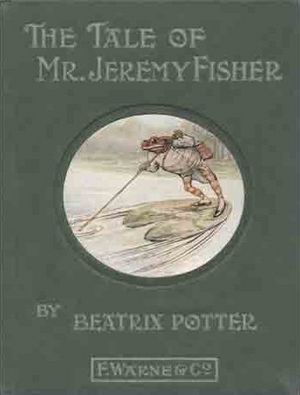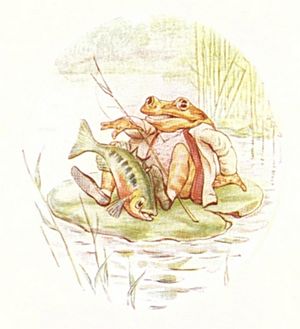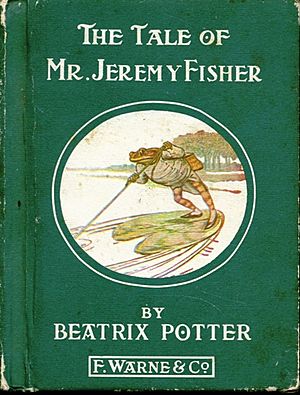The Tale of Mr. Jeremy Fisher facts for kids

First edition cover
|
|
| Author | Beatrix Potter |
|---|---|
| Illustrator | Beatrix Potter |
| Country | England |
| Language | English |
| Genre | Children's literature |
| Publisher | Frederick Warne & Co. |
|
Publication date
|
July 1906 |
| Media type | Print (Hardcover) |
| Preceded by | The Tale of the Pie and the Patty-Pan |
| Followed by | The Story of a Fierce Bad Rabbit |
The Tale of Mr. Jeremy Fisher is a children's book, written and illustrated by Beatrix Potter. It was published by Frederick Warne & Co. in July 1906. Jeremy's origin lies in a letter she wrote to a child in 1893. She revised it in 1906, and moved its setting from the River Tay to the English Lake District. The tale reflects her love for the Lake District and her admiration for children's illustrator Randolph Caldecott.
Jeremy Fisher is a frog that lives in a "slippy-sloppy" house at the edge of a pond. During one rainy day, he collects worms for fishing and sets off across the pond on his lily-pad boat. He plans to invite his friends for dinner if he catches more than five minnows. He encounters all sorts of setbacks to his goal, and escapes a large trout who tries to swallow him. He swims for shore, decides he will not go fishing again, and hops home.
Potter's tale pays homage to the leisurely summers her father and his companions passed sport fishing at rented country estates in Scotland. Following the tale's publication, a child fan wrote to Potter suggesting Jeremy find a wife. Potter responded with a series of miniature letters on the theme as if from Jeremy and his pals. After Potter's death in 1943, licences were issued to various firms to produce the Potter characters. Jeremy and his friends were released as porcelain figurines, plush toys, and other merchandise.
Plot
Jeremy Fisher is a frog that lives in a damp little house amongst the buttercups at the edge of a pond. His larder and back passage are "slippy-sloppy" with water, but he likes getting his feet wet; no one ever scolds and he never catches cold. One day, Jeremy finds it raining and decides to go fishing. Should he catch more than five minnows, he would invite his friends to dinner. He puts on a mackintosh and shiny galoshes, takes his rod and basket, and sets off with "enormous hops" to the place where he keeps his lily-pad boat. He poles to a place he knows is good for minnows.
Once there, the frog sits cross-legged on his lily-pad and arranges his tackle. He has "the dearest little red float". His rod is a stalk of grass and his line a horsehair. An hour passes without a nibble. He takes a break and lunches on a butterfly sandwich. A water beetle tweaks his toe, causing him to withdraw his legs, and rats rustling about in the rushes force him to seek a safer location. He drops his line into the water and immediately has a bite. It is not a minnow but little Jack Sharp, a stickleback. Jeremy pricks his fingers on Jack's spines and Jack escapes. A shoal of little fishes come to the surface to laugh at Jeremy.
Jeremy sucks his sore fingers. A trout rises from the water and seizes him with a snap (Mr. Jeremy screams, "OW-OW-OW!!!"). The trout dives to the bottom, but finds the mackintosh bad-tasting and spits Jeremy out, swallowing only his galoshes. Jeremy bounces "up to the surface of the water, like a cork and the bubbles out of a soda water bottle", and swims to the pond's edge. He scrambles up the bank and hops home through the meadow, having lost his fishing equipment but quite sure he will never go fishing again.
In the last few pages, Jeremy has put sticking plaster on his fingers and welcomes his friends, Sir Isaac Newton, a newt; and Alderman Ptolemy Tortoise, a tortoise that eats salad. Isaac wears a black and gold waistcoat and Ptolemy brings a salad in a string bag. Jeremy has prepared roasted grasshopper with ladybird sauce. The narrator describes the dish as a "frog treat", but thinks "it must have been nasty!"
Background
In addition to the pet frogs of Potter's youth, influences on Jeremy include Potter's sport fishing father Rupert William Potter and illustrator Randolph Caldecott. Margaret Lane, author of The Magic Years of Beatrix Potter, notes, "Mr. Potter was fond of taking his friends fishing and Beatrix ... from an early age had been familiar with [the] hazards and excitements of angling and dry-fly fishing ... as a girl [she] had often enough had to endure her father and his friends relating their fishing adventures, and the picture of Mr Jeremy Fisher retailing his mishap to Sir Isaac Newton is so rich in observation, both of amphibians and elderly gentlemen, that one is ever afterwards prone to confuse them in memory". Mr. Potter not only fished for sport but collected the works of Randolph Caldecott. In Jeremy Fisher, Potter tried to copy Caldecott but felt she had failed. "I did try to copy Caldecott," she stated, "but ... I did not achieve much resemblance." Biographer Linda Lear writes Potter declared, "I have the greatest admiration for his work – a jealous appreciation; for I think that others, whose names are commonly bracketed with his, are not on the same plane at all as artist-illustrators".
Potter biographer Linda Lear and author of Beatrix Potter: A Life in Nature writes:
[Potter] wanted to do a frog story for some time, because it was amusing and offered the opportunity for the naturalist illustrations she delighted in ... The story of a fisherman down on his luck reminded Beatrix of the 'fish stories' her father's friends had told in Scotland, as well as her brother's travails with rod and reel. She also recreated the gentlemen's club atmosphere absorbed from her father's reports of evenings spent at the Reform and the Athenaeum ... The text and illustrations for this story are some of the most balanced and compatible of all her writing. Nature is described and illustrated truthfully: beautifully tranquil as well as unpredictably aggressive ....Its carefully coloured botanical backgrounds of water plants, a frog with anatomically correct turned-out feet, a trout that any self-respecting fisherman would enjoy snagging, and a rather frighteningly rendered water-beetle who tweaks Jeremy's dainty toes, all made it a delight to look at as well as to read.
Miniature letters
About 1907 Potter created miniature letters delivered to child fans in either a miniature mail bag or a miniature mail box. "Some of the letters were very funny," Potter wrote, "The defect was that inquiries and answers were all mixed up."
Four Jeremy letters were written at about 1910 to Drew Fayle who thought Jeremy should marry. In one letter, Sir Isaac promises Master Fayle a piece of wedding cake should Jeremy marry and, in another letter, Ptolemy writes that Jeremy's parties "would be much more agreeable if there were a lady to preside at the table." Jeremy writes in the third letter: "When I bought my sprigged waistcoat & my maroon tail-coat I had hopes ... but I am alone ... if there were a 'Mrs. Jeremy Fisher' she might object to snails. It is some satisfaction to be able to have as much water & mud in the house as a person likes."
Mrs. Tiggy-winkle, a hedgehog washerwoman in another Potter tale, writes Master Fayle in the fourth letter:
Dear Master Drew,
If you please Sir I am a widow; & I think it very wrong that there is not any Mrs. Fisher, but I would not marry Mr. Jeremy not for worlds, the way he does live in that house all slippy-sloppy; not any lady would stand it, & not a bit of good starching his cravats.
Yr. obedient washerwoman, Tiggy Winkle.
Merchandise
The characters from Jeremy Fisher have appeared as porcelain figurines, plush toys, and other merchandise. In 1950, Beswick Pottery issued a porcelain figurine of Jeremy and figurines of Isaac and Ptolemy in the 1970s. Other figurines of Jeremy have been produced over the years as well as a Jeremy mug. Jeremy was one of the first eight plush toys released by Eden Toys, Inc. of New York in 1973. The following year, he was released as a 37 inches (94 cm) "Giant" intended for store displays, and during the Beanie Baby era as a beanbag. Isaac Newton was on store shelves for two years.
Jeremy Fisher was one of the first ten character music boxes released by Schmid & Co. in 1977. Ptolemy and Isaac boxes were released in the 1980s. Ceramic Christmas ornaments of Jeremy have been released by Schmid. Other merchandise includes a variety of Crummles enamelled boxes, an ANRI wood carving and ANRI Toriart figurines and ornaments, and Huntley & Palmer biscuit tins.
Reprints and translations
As of 2010, all 23 of Potter's small format books remain in print, and are available as complete sets in presentation boxes, and as a 400-page omnibus edition. The English language editions of the tales still bore the Frederick Warne imprint in 2010 though the company was bought by Penguin Books in 1983. Penguin remade the printing plates in 1985, and all 23 volumes were released in 1987 as The Original and Authorized Edition.
Although sold to Penguin Books in 1984 as a subsidiary company, Frederick Warne continues to publish Potter's books. A 2002 Publishers Weekly article, written for the centennial of the publication of The Tale of Peter Rabbit, reported that Potter was considered one of the top most popular classic writers, that anniversary editions of her work were published in 1993 and 2002, and the artwork has been "re-scanned to make the illustrations look fresher and brighter".
The Tale of Mr. Jeremy Fisher was published in French in 1940 as Jérémie Pêche-à-la-Ligne, and in Dutch as Jeremais de Hengelaar in 1946. The tale was republished in Dutch in 1970 as Het Verhaal van Jeremais Hengelaar and was published in the Initial Teaching Alphabet in 1965. In 1984, the tale was again translated into French by M.A. James as L’histoire de Monsieur Jérémie Peche-a-la-Ligne. In 1986 MacDonald wrote that Potter's books had become a "traditional part of childhood in most only English-speaking countries and in many of the countries into whose languages Potter's books have been translated".
Adaptations
- An abbreviated version of the tale appeared as a segment in the 1971 ballet film, The Tales of Beatrix Potter.
- The tale was adapted to animation, along with The Tale of Mrs. Tiggy-Winkle, as an episode of the 1992 BBC television series The World of Peter Rabbit and Friends.
- Mr. Jeremy Fisher appears in the 2012 CGI animated television series of Peter Rabbit in Nickelodeon. Jack Sharp and Alderman Ptolemy Tortoise (instead named Mr. Tolly Tortoise) also appear in the series.
- Mr. Jeremy Fisher appears in the 2018 animated/live-action film adaptation of Peter Rabbit, voiced by Domhnall Gleeson.



